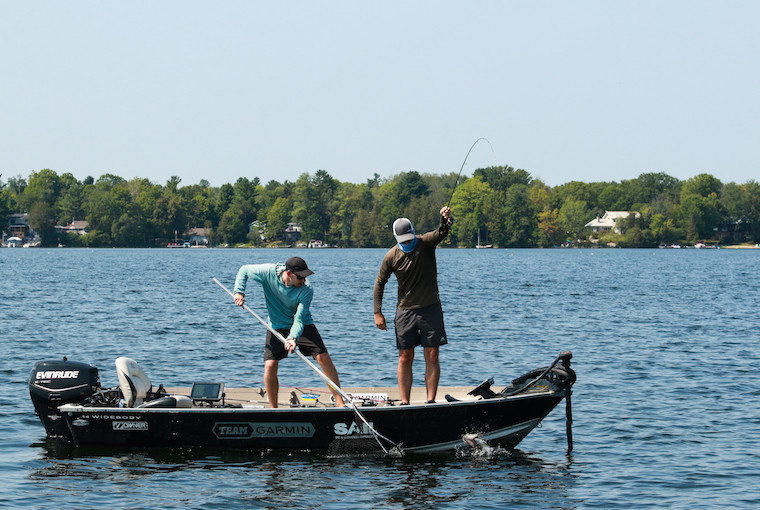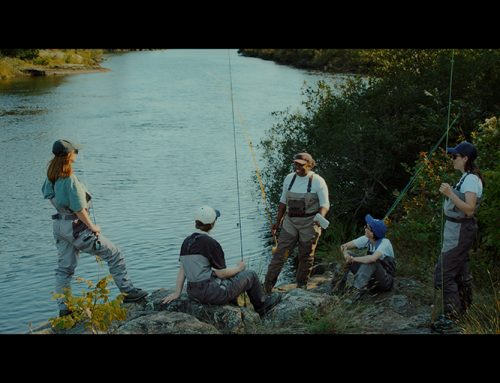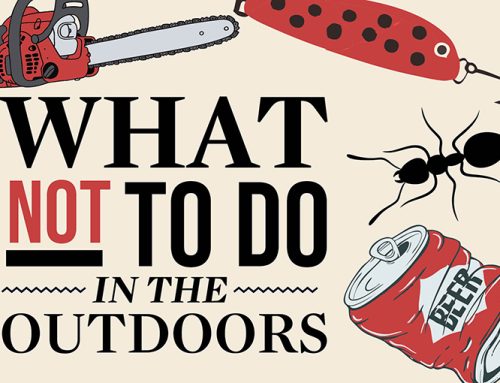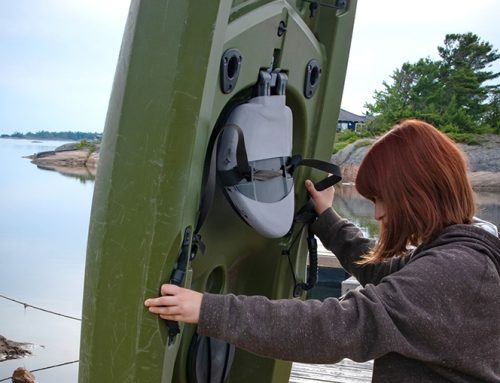
Most of us are familiar with the old adage, “A bad day of fishing is better than a good day of work,” and I’m certain we’d unanimously agree.
As much as we relish time on the water, some of us may wish we were toiling at the nine-to-five instead when changing weather patterns are thrown into the mix.
Two weather patterns we’ve all faced when fishing for bass include heat waves and cold fronts. They are opposites in so many respects, but more than fishable with the right knowledge and adjustments.
The dog days of summer
“Typically, water temperature in the range of 60 to 85 ̊F is preferred by both smallmouth and largemouth bass. The latter preferring the higher end of the spectrum,” explained aquatic biologist and Pure Fishing Ambassador Jason Barnucz. “When water temperatures exceed these limits bass behaviour can slow down and may seek out water with better temperature.”
“Changes in weather patterns can influence bass behaviour positively or negatively. During summer months weather patterns tend to be more stable. Several days of stable weather will see fish on the move for prey and generally more active. Cold fronts, after extended periods of stable weather, can negatively impact bass behaviour. Causing them to forage less and become more sedentary.”
Largemouth bass
A heat wave is defined as a period of abnormally hot weather generally lasting more than two days. As anglers, we know them all too well as blazingly hot and humid. When unprotected skin scorches and surface water takes on the temperature of bath water. Conditions like these can take a toll on an angler’s body and mind. Not to mention the effect they have on our favourite bass species.
“For largemouth, I look for the heaviest cover nearby deep-water access,” said Renegade Bass Tour and Shootout Series pro David Chong. “The heavier the cover the better, as the water beneath is significantly cooler. Mixing it up in this cover is often an abundance of food, which is a major attraction. Think slop mats, thick lily pad beds, or weeds that have extensive canopies overhead.”
Bassmaster Open pro Cooper Gallant echoed that. “The biggest thing is to find something different. Look for irregularities, seek out good green weed, and most importantly, find cover and cooler water. I also pay attention to where major spawning areas are in a lake,” he said. “Largemouth bass, especially those trophy fish, are not as likely to move very far after their spawn.”
Water temperature can change by as much as 10 ̊F for every 10 feet of depth. This is a significant consideration when searching for largemouth bass.
“During an intense heat wave, I spend 70% of my time looking deeper. Being a tournament angler, deep fish are so much more reliable. And I truly believe that there is a very large population of bigger largemouth that live in water eight feet deep and greater. Especially during those warmest weeks of the season,” added Gallant.
Garmin and Sail prostaffer Anthony Cameron agreed. “I usually like to locate deep weed lines during those dog days by running the standard 2D CHIRP,” he said. “Once found, a switch to the Garmin LiveScope allows me to find bait mixed in with the weeds or schools of small panfish cruising through. Find the food source and you’ll locate the bass. If I fail to see any fish or I’m consistently catching smaller largemouth, I will begin pushing up into shallow water until I connect with those bigger bass.”
Electronics are also a key for Chong’s hot weather repertoire. “The ability of today’s forward-facing sonar like the Garmin LiveScope allows me to see if the fish have actually left or if they are still where I found them previously,” he said. “If they haven’t moved and it’s just that their mood has changed then I need to find a way to catch them.”
Smallmouth bass
Late last August, I sweated through one of the hottest days I had ever experienced on the water. An outing that saw the mercury reach 39 ̊C.
With Cameron and his brother Andrew in their boat and myself in mine, we hit up an eastern Ontario lake for smallmouth.
Instinctively we assumed the bass would be down deep. And if it wasn’t for electronics that day, we may have caught nothing more than heat stroke.
Anthony is a pro when it comes to Garmin wizardry. Electronics literally led us, or should I say them, to the fish that day. “Cruising over a massive 55-foot flat, I began marking small bait balls under the boat with the 2D CHIRP, ClearVu, and SideVu. Once I fired up the LiveScope, I spotted massive bait balls out from the boat, almost at the surface, with smallies gorging on them in a frenzy. I was able to stay with these moving schools of bait, and find others, and consistently connect with bass. It was one of the best days of fishing I had all year,” Cameron recalled.
“I will look deep for smallmouth bass whatever lake I am on when those heat waves hit from August through September. It might only be 21 feet on Lake St. Clair but 40 to 50 feet on Lake Erie,” stated tournament pro Derek Strub.
Gallant takes the same approach, but with one caveat. “I like to fish for big smallmouth bass deep throughout the dog days of summer. Typically when the water is very warm, the majority of the fish will be down in the depth. Cruising or chasing bait, or hunkered down on structure. Keep an open mind about the shallows. Some of the biggest smallmouth on any lake will also be lurking in the skinny water gorging on gobies and crawfish.”
Time of day can also dictate fish activity levels, as OOD Bass Columnist Luigi De Rose discovered. “I got onto a pattern a few summers back during an intense heat wave. Having two teenagers meant an early start was never going to happen. We arrived at the lake around 2 p.m. To my surprise, the heat wave had the smallmouth hunting and we caught plenty of fish. My kids were in action all afternoon and once the oppressive sun started to decrease its intensity, the bite disappeared. I wasn’t too mad about missing the morning session as I am positive it was the high overhead sun that really wound up the bass that day.”
One rule of thumb for Chong during hot summer days is he always looks shallow on sand flats before heading out to find them in deeper water.
“On certain bodies of water such as Lake Simcoe, the hotter it gets, the shallower the smallies tend to hang out. Typically, these areas have a sand bottom with sporadic rock piles mixed in,” he said.
The dreaded cold front
Largemouth bass
In terms of challenging weather conditions, most anglers would agree that cold fronts rate as the worst. The simple definition of a cold front is a cold air mass replacing a warmer one. Cold fronts usually move from northwest to southeast and bring with them sudden temperature drops, high winds, and rain. Bluebird skies often follow the passage of these fronts.
“The key to fishing during cold front conditions is understanding that the bite will most likely be tough and few and far between,” Chong said. “Slowing down can be vital in getting those minimal bites and you must be prepared to set on anything. For largemouth bass that means targeting deeper mud bottom bays, those that are filled with milfoil, and fish the pockets in those weed-beds extremely slow.”
“Of the two species of bass, largemouth are most affected by cold front conditions due to the fact that they typically live in shallow environments,” Barnucz said. “During these fronts, largemouth may seek out areas of dense cover. Such as weed-beds and wood, and may not be willing to move to forage, opting to let the weather front pass before taking up active feeding behaviour.”
Adapting and changing your mindset is part and parcel when dealing with fronts. A lesson Strub learned while fishing a year-end Classic.
“The event was in early September, and when we got to the launch there was ice on the boat. At noon we had an empty livewell. We made the move to a current area adjacent to a river and found active largemouth that weren’t affected by the cooling lake temperature,” he said. “We ended up getting a good limit that day as well as the next to finish the event in third place. We would have bombed if we didn’t make that move.”
Smallmouth bass
Although an easier fish to target during cold fronts, smallmouth bass can still cause anguish for anglers not willing to adapt.
One tournament experience from Dave Chong highlights the smart way to tackle the weather. “When Doug Brownridge and I won the 2015 Renegade Classic, we had found some great smallies and were catching them on a Carolina rig, dragging it in the current. Well, on Friday a strong cold front rolled through along with wicked winds and heavy rain. All with a severe drop in air temperature. We managed fine on day one, as often it takes a day or so for the fish to be affected by strong fronts. But on day two they were a lot tougher to get going. We eventually went down to a small two-and-a-half-inch tube and used our trolling motor to slow us down as much as possible. By adjusting our speed and downsizing to a smaller bait we were able to get the five bites we needed to win the event,” Chong explained.
De Rose offered up these words of wisdom on the matter. “The first day after a front seems to affect anglers more than bass. The second day, if the water becomes cold, I will seek out more sunny spots for smallmouth and avoid super shallow locations,” he said. “If it is very windy I’ll take advantage of it, switching to fast-moving bait if my primary patterns fail to produce. Don’t be afraid to change things up. Sometimes thinking outside the box can make a big difference.”
Originally published in the July 2022 issue of Ontario OUT of DOORS






Leave A Comment